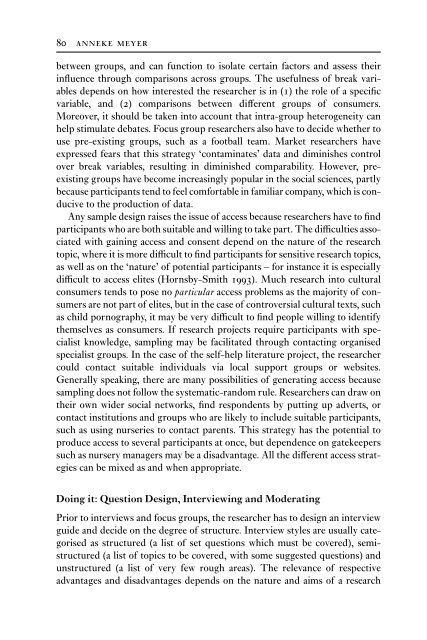Research Methods for Cultural Studies
Research Methods for Cultural Studies
Research Methods for Cultural Studies
You also want an ePaper? Increase the reach of your titles
YUMPU automatically turns print PDFs into web optimized ePapers that Google loves.
80 anneke meyer<br />
between groups, and can function to isolate certain factors and assess their<br />
influence through comparisons across groups. The usefulness of break variables<br />
depends on how interested the researcher is in (1) the role of a specific<br />
variable, and (2) comparisons between different groups of consumers.<br />
Moreover, it should be taken into account that intra-group heterogeneity can<br />
help stimulate debates. Focus group researchers also have to decide whether to<br />
use pre-existing groups, such as a football team. Market researchers have<br />
expressed fears that this strategy ‘contaminates’ data and diminishes control<br />
over break variables, resulting in diminished comparability. However, preexisting<br />
groups have become increasingly popular in the social sciences, partly<br />
because participants tend to feel com<strong>for</strong>table in familiar company, which is conducive<br />
to the production of data.<br />
Any sample design raises the issue of access because researchers have to find<br />
participants who are both suitable and willing to take part. The difficulties associated<br />
with gaining access and consent depend on the nature of the research<br />
topic, where it is more difficult to find participants <strong>for</strong> sensitive research topics,<br />
as well as on the ‘nature’ of potential participants – <strong>for</strong> instance it is especially<br />
difficult to access elites (Hornsby-Smith 1993). Much research into cultural<br />
consumers tends to pose no particular access problems as the majority of consumers<br />
are not part of elites, but in the case of controversial cultural texts, such<br />
as child pornography, it may be very difficult to find people willing to identify<br />
themselves as consumers. If research projects require participants with specialist<br />
knowledge, sampling may be facilitated through contacting organised<br />
specialist groups. In the case of the self-help literature project, the researcher<br />
could contact suitable individuals via local support groups or websites.<br />
Generally speaking, there are many possibilities of generating access because<br />
sampling does not follow the systematic-random rule. <strong>Research</strong>ers can draw on<br />
their own wider social networks, find respondents by putting up adverts, or<br />
contact institutions and groups who are likely to include suitable participants,<br />
such as using nurseries to contact parents. This strategy has the potential to<br />
produce access to several participants at once, but dependence on gatekeepers<br />
such as nursery managers may be a disadvantage. All the different access strat -<br />
egies can be mixed as and when appropriate.<br />
Doing it: Question Design, Interviewing and Moderating<br />
Prior to interviews and focus groups, the researcher has to design an interview<br />
guide and decide on the degree of structure. Interview styles are usually categorised<br />
as structured (a list of set questions which must be covered), semistructured<br />
(a list of topics to be covered, with some suggested questions) and<br />
unstructured (a list of very few rough areas). The relevance of respective<br />
advantages and disadvantages depends on the nature and aims of a research


